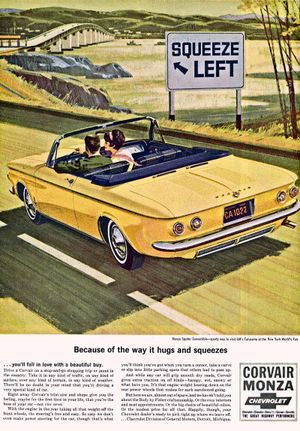Collector Car Corner: Corsair vs. Edsel
Q: Greg, I really liked the Corvair articles you’ve written through the years, and am wondering how you feel about the Edsel? It was a new car, but failed miserably back in 1958. What are your thoughts when compared to the Corvair? Walter S., Pennsylvania.
A: Walter, first let’s separate the Corvair from the Edsel in one big way: the Corvair was a true innovation and an all-new effort from General Motors in 1960. The Corvair featured a rear mounted six cylinder air cooled engine coupled to a transaxle with what I always felt was a good looking, compact design.
The Edsel was introduced late in 1957 as a 1958 model and was nothing more than a “gadgets and gimmicks” car with new sheet metal on what was still a Ford-Mercury chassis. Therefore, the Corvair will always be regarded in this column as an innovative car, while the Edsel a non-innovative vehicle.
Corvair’s demise can be attributed to a single chapter in a 1965 book called “Unsafe at Any Speed” by author/politician/activist Ralph Nader. Until Nader’s book appeared, Corvair sales totaled 1,677,455 from 1960 to 1965. Post-Nader sales of the Corvair 0were dismal, as from 1966 to its final year in 1969, only 158,532 Corvairs were sold. Nader zeroed in on Corvair's ill handling attributes when the rear tires were low on tire pressure and there were many litigation suits against GM that followed.
Edsel, meanwhile, hoped to sell the American consumer via slick advertising campaigns and the “new” Edsel gimmicks, like push-button transmission buttons in the center of the steering wheel and a rotary speedometer. The American consumer was not sold by the design and saw right through the ad campaign.
Still, there was so much hyped advertising, and even an “Edsel TV Show,” that you thought something “out of this world” was about to hit the dealer showrooms. When it finally arrived, Edsel was a bust from day one.
Another reason I feel Edsel failed was the name. Now I’m sure Edsel Ford, who was the son of Henry Ford, was a nice person. But the name Edsel just doesn’t have the rhyme to it like Lincoln-Mercury-Ford and Ford-Mercury-Lincoln models like Thunderbird, Continental, Fairlane, Marauder, Montclair and so on.
Most notable in the Edsel saga was disgruntled union workers, of which my uncle was one at the Edison/Methuen plant in New Jersey. As for the Edsel design, it was “way out there,” with an “in your face” front grille that was not liked much by most consumers. Most called Edsel’s front design a “scoop nose, “hangman’s noose” or “snorkel” front end that didn’t seem to match what I feel was a nicely styled trunk and rear tail light design.
As for promotion, Edsel was initially marketed to its dealers as an “Edsel only” division, but it didn’t last long following dealer unhappiness and the need for extra monies to carry the stand-alone Edsel brand. Ford relented, and the Edsel ended up at all Lincoln-Mercury dealers in a move to sandwich the Edsel between its two successful marks, Mercury and Lincoln. Ford’s theorists felt Edsel would then compete for the Oldsmobile-Pontiac-Dodge-Desoto “middle level” consumer, but in reality the Edsel probably negatively impacted Mercury sales more so than the competition.
As for the union members, there were “quality problems” from day one as employees had to “fit the Edsel in” on their regular Mercury assembly lines. It was common knowledge at the Mercury plants that the workers were very upset that Ford would just throw a brand new model onto the assembly line without any monetary consideration or enhanced bonus structure for union workers. Thus, there were many quality “issues” on these Mercury assembly lines when the Edsel was put together and, not surprisingly, very few if any problems when the Mercury brand was assembled by the same workforce.
By 1959, Edsel sales were tanking as the design was relegated to a front and rear end facelift. In Edsel’s final year of 1960, it was a near identical Ford design sans the grille and tail lights. When all was said and done, the only thing Edsel achieved in its three year run was being labeled as the worst car introduction and sales flop in motoring history.
Still, when an Edsel or Corvair appears nowadays at a car show there’s always a crowd around to see them up close. Thus, the Edsel and Corvair finally have their day in the sun and combined with the lack of monetary appreciation through the years, both cars offer an excellent doorway to the fascinating collector car hobby for less than $10,000 in decent condition.
Thanks Walter for your question.
(Greg Zyla is a syndicated car columnist who welcomes reader questions or comments on old cars, auto nostalgia and motorsports at 303 Roosevelt St., Sayre, Pa. 18840 or email at greg@gregzyla.com).

